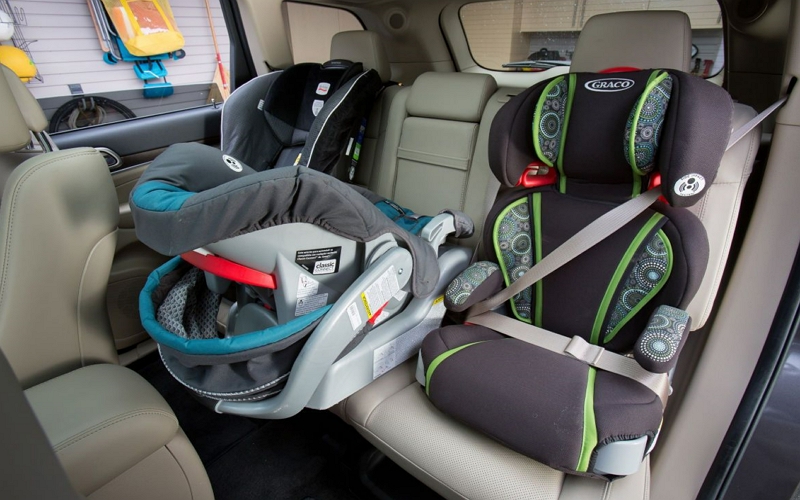When can a baby go in a forward facing car seat? A baby can go in a forward-facing car seat when they weigh at least 22 pounds, regardless of whether or not their feet touch the footrest.
At this weight, it is safe for them to ride with an adult belt-positioning booster system (which may be used until 40-100 lbs).

Once your child reaches 40 lbs and/or 38 inches tall, you can consider transitioning him or her to a regular belt-positioning booster system without the back support of the harnesses.
The shoulder belt should fit snuggly on his chest and across his hips. The lap part of the belt sits low on his upper thighs while touching but not compressing against his belly button area.
A highback booster allows children who don’t outgrow the harness system to use the same car seat until they are at least 100 lbs.
At this weight, it is safe for them to ride with a regular belt-positioning booster system without the back support of the highback. The shoulder belt should fit snuggly on his chest and across his hips.
The lap part of the belt sits low on his upper thighs while touching but not compressing against his belly button area.
When can baby face forward in car seat 2015?
When can baby face forward in car seat 2015? There is no specific age when a child has to turn around and sit facing the back of their car seat.
It just depends on your little one’s size, weight, and height. For example, if you have a newborn that does not meet all three of these requirements then it may be unsafe for them to ride sitting backwards since they are so small and fragile.
However, some children who weigh more than 40 pounds at less than 40 inches tall could still be perfectly safe riding without their rear-facing restraints.
To ensure safety during travel with your kids make sure you check out our article “Top Five Car Seats” where we compare everything from installation methods to crash ratings!
What car seat should my child be in?
A car seat is a protective device designed to prevent injury from sudden stops or crashes. It can be made of plastic, foam and other materials that compress upon impact. A child safety seat must meet federal motor vehicle standards in the United States before it can legally be sold there.
The National Highway Traffic Safety Administration (NHTSA) recommends rear-facing seats for infants up to two years old and forward-facing ones for older children until they are at least four feet nine inches tall—about age twelve or thirteen.
At what age do babies change car seats?
There is no official age that determines when a child should change car seats. The AAP recommends keeping children rear-facing in the backseat for as long as possible, and there are benefits to doing so even after they outgrow their infant car seat (some kids may still be within the weight or height limits of an infant carrier well into toddlerhood).
However, many parents choose to switch from an infant carrier around one year old because it tends to feel much more comfortable than having their baby facing backwards in such a small space.
If your child seems like he/she has outgrown his/her current model but you don’t want him/her forward-facing yet, consider taking advantage of some travel systems designed specifically for toddlers with higher top harness slots.
What is the latch system for car seats?
The latch system is the belt or strap that holds your car seat into your vehicle. The latch system is important to keep secure during a crash event, so you want to make sure it’s safe and working properly before each trip.
A good rule of thumb is just like buckling up yourself in the passenger seat, always check that your child’s restraint has been secured with its buckle after installation!
If there are any issues with the LATCH straps for baby capsules, forward-facing seats, or booster seats – get them repaired ASAP by an expert technician at our shop!
We don’t recommend using another person’s car seat as they may have been involved in an accident or received repairs from someone else without knowing if those repairs were done correctly.
The following are the most important things to look for when checking your child’s car seat:
– Is it facing backwards? If so, stop! The safest place for a baby or toddler is in the backseat – always ride rear-facing.
If you’re still unsure about which seats are best suited for your family, please don’t hesitate to contact us! We would be happy to help and answer any of those burning questions you may have.
Lastly, remember that we’re here as a support system – regardless if this is your first time installing one of these bad boys or not – so feel free to give us a call with ANY issues/concerns you might have before hitting the road! Remember to stay safe out there!
We’re here to help you! If it’s your first time installing or if you have questions, don’t hesitate to contact us. We would be happy to answer all of those burning questions from our customers.
Remember that we are a support system – no matter how experienced you may feel with these car seats. Give us a call whenever necessary before taking the road again! Drive safely, everyone.
